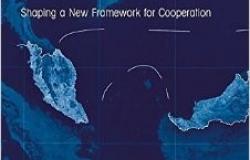Book Review: Non-Traditional Security Issues and the South China Sea: Shaping a New Framework for Cooperation

Non-Traditional Security Issues and the South China Sea: Shaping a New Framework for Cooperation edited by Shicun Wu and Keyuan Zou. Farnham, Surrey, England; Burlington, VT, USA: Ashgate 2014. 295 pp, £70/$124.95 hardcover 9781409461937
Historically, the South China Sea has had outstanding strategic and geo-economic significance to the world. The editors and contributors to Non-Traditional Security Issues and the South China Sea provide new scholarly insights on the most critical and threatening of the non-traditional security issues in this region, re-examine the key features of the existing coordination mechanisms for security governance in the South China Sea and other sensitive sea areas (e.g., the Arctic and the Gulf of Aden), and explore the creative solutions and compromises needed to tackle non-traditional security issues in the foreseeable future.
Non-Traditional Security Issues and the South China Sea has fourteen chapters, which are written by the leading established scholars and some of the most promising ones in the study of non-traditional security and the South China Sea. This collection of essays has five thematic parts. In Part I (chapter 1), the editors Shicun Wu and Keyuan Zou address the outline of chapters. At the regional level, the following pages (chapters 2-4) analyse the dynamic challenges facing the governance of non-traditional security issues in the South China Sea. In Part III (chapters 5-7), Johan Saravanamuttu, Mingjiang Li and Nong Hong explore creative solutions and compromise needed to tackle the non-traditional security issues in the foreseeable future, although there is no major breakthrough or consensus on the sovereignty issues, and “no sign of resolution of territorial and maritime disputes” (p.107).
In the case of counter-piracy, the next part (chapters 8-10) emphasises the potential solutions to maritime piracy in the South China Sea. In addition, the contributors explore the components of the current legal framework for security governance in the South China Sea, including the United Nations Convention on the Law of the Sea (UNCLOS), the Convention for the Suppression of Unlawful Acts, the Hostages Convention (formally the International Convention against the Taking of Hostages) and the UN Convention against Transnational Organized Crime (UNTOC). It is noteworthy that the current legal framework does not “deal with the problem of evidence collection at sea” (p.166). In the last part (chapters 11-14), Keyuan Zou, Thomas Grieder, Robin Warner and Lingjie Kong focus on the potent non-traditional security issues in the South China Sea, such as climate change, sustainable development, and marine environment degradation.
This collection of essays offers three contributions to the literature of non-traditional security issues in the South China Sea. First of all, the most intractable barrier is territorial sovereignty. When sovereignty disputes involve hydrocarbon reserves in the South China Sea, the stakeholders’ “lack of political commitment to create and support a strong regional institutional mechanism” mean that the possibility of avoiding a zero-sum game would be slim (p.269). At present, the overlapping and conflicting sovereignty claims of littoral states have “undermined most attempts at cooperation on marine matters” in the South China Sea (p.33), and maritime boundaries have become more blurred that what they used to be. As a result, China has been losing “most from the status quo due to the nature of its sovereignty claims” (p.240), while ASEAN could not play “the role of third-party mediator” between China and four of its members (i.e., Vietnam, Philippines, Malaysia, and Brunei Darussalam) (p.66). In the meantime, the divide on the principle of “one China” prevents China and Taiwan from establishing military cooperation in the South China Sea.
If any claimants downplay sovereign claims in the South China Sea, this would probably trigger domestic nationalistic sentiment. It does not exclude the possibility of “mobilizing domestic dissent and channeling it away from the government towards external adventurism” (p.26). Therefore, it is not surprising that “norm setting for joint development” in this region has been “a sluggish exercise” (p.88): even the United Nations Commission on the Limits of the Continental Shelf could play a “very limited role” (p.6).
Secondly, when ASEAN tries to reconcile the members’ claims and China’s claims, the most essential stabiliser is the economic relationships between China and ASEAN members. Although some ASEAN members (e.g., the Philippines and Vietnam) made efforts to solidify a consensus against China in South China Sea, the other ASEAN members would not take a collective stand on the sovereignty issues, as their predicament is that they wish to make full use of China’s rapid economic growth. However, no country can maintain high-speed economic growth forever. What will happen in the South China Sea, if China cannot sustain a high speed of economic growth?
Thirdly, the editors and contributors advance creative solutions, in response to the non-traditional security issues in the South China Sea. In the words of Johan Saravanamuttu, “the actual character of cooperation varies from case to case” (p.83). One the one hand, as Ramses Amer addresses, it is necessary to “reconcile the views and interests of all ten member states [of ASEAN] with diverging relationships and perceptions of China” (p.70). In some cases, talk of “cooperation can also be targeted at destruction of collective agency in an issue area, if cooperation talk includes some elements of a collective actor, while excluding others” (p.18). On the other hand, achievements can be more possible in “a smaller group of members” (p.108).
One of the proper solutions might be a regional regime (e.g., the Arctic Council), under which “all the claimant states and other non-claimant coastal states could address many issues of common concern” (p.128). Until now, such a regime has not been available for the South China Sea. In fact, Somalia might be an exception. Because this country has “no coastguard or naval capacity”, so the foreign counter-piracy forces under the U.N. mandate could “operate in relative harmony” (pp.199-200).
In the opinion of Keyuan Zou, the stakeholders should try a moratorium, in which “each claimant will agree not to explore and exploit any mineral resource including oil and gas beyond its territorial sea for at least 50 years” (p.220). In addition, as Andrew Erickson and Austin M. Strange suggest, if possible, the stakeholders should “pursue initiatives such as information sharing that exploit transnational information commons” (p.204).
This well-researched volume inspires new investigations and new knowledge about non-traditional security issues in the South China Sea, as well as leaving open questions worthy of future research. The editors and contributors pay little attention to private security contractors – another factor that invites the security interests of non-regional powers into the South China Sea. It is increasingly hard to ignore the rise of private security contractors’ presence in the South China Sea, as they not only gather and analyse intelligence and information from all sources, but also provide on-board security and naval escort. However, some littoral states always consider anti-piracy to be “a matter of national prestige”, and that the involvement of foreign forces in anti-piracy will “potentially erode their exclusive control” (pp.118-119). What is the perspective on private security contractors’ involvement in the South China Sea? How will the littoral states respond? These questions remain to be answered.
Undoubtedly, Non-Traditional Security Issues and the South China Sea is a valuable resource for scholars and students interested in the study of non-traditional security issues and the South China Sea. Moreover, this collection of essays will be of interest to serious libraries, and general readers will find it thought provoking.
Kai Chen, Ph.D., is an assistant professor at the Center for Southeast Asian Studies, School of International Relations, Xiamen University, China. Previous positions include postdoctoral research fellow at the School of Public Administration, Zhejiang University, China (2012-2015), visiting scholar at the East Asian Institute, National University of Singapore (November 2013-May 2014), and postdoctoral fellow at the School of International Relations and Public Affairs, Fudan University, China (2009-2011). His principal research contributions are in the areas of international security, geo-strategic relations, and security governance in East Asia, especially Southeast Asia and China. He is the author of Comparative Study of Child Soldiering on Myanmar-China Border: Evolutions, Challenges and Countermeasures (Singapore and New York: Springer, 2014).


